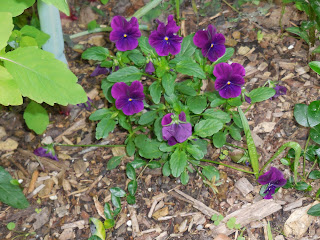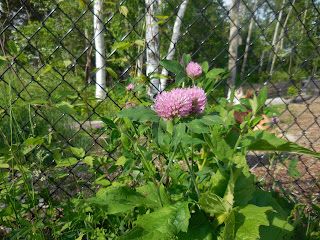There's a church on the land near the Barn Theater; during intermission the sun set and produced this cool shot.
Waterlilies from my Royal Oak pond
Many years ago I bought some Swiss Alpine runner-less strawberries. They were red but eventually produced some white berries from seeds which is a reliable way to produce more plants. They can also be divided. I moved some white ones up here and have started more from seeds. I prefer the white because the birds don't recognize them as ripe and leave them for me. They are exceptionally good tasting although small. In order to start more plants I have to resist eating the berries. OK, OK! I promise I'll do that soon. The white strawberries reliably produce only new white berry producing plants. The berry below is about the size of your little fingernail but packs a lot of flavor.
My "Wee Hoose"
I discovered variegated leaf geraniums last summer. Even when they are not flowering, I think they are pretty, as pretty as coleus but they also have flowers. These named varieties go back to the 1800's. It has not been warm this summer here; when the heat comes, they will have really nice flowers too. The first three, which the hummingbirds enjoyed last summer, survived the winter in the garage. The last two are new to me this year.
Plants for me are like photo albums are for other people; they bring back memories from my past.
There was a forsythia bush outside the dining room window of my childhood house in Royal Oak. Before every move, I've started new ones and transplanted them. I brought four very small shrubs up to Sans Souci with me; three survived and are starting to grow this summer. (Remember? Sleep, Creep, Leap!) I prefer small plants because I think they make the transition better; plus small ones are a whole lot easier to move and don't usually get set back!
When we moved into our Royal Oak house on 13 Mile, our elderly neighbor had old fashioned species Hosta in his yard. Smith was in his eighties and donated plants for our yard. I think they were Hosta ventricosa and Hosta ventricosa aureomaculata. The latter has variegated leaves in the spring when it first emerges and then gradually the leaves change to solid green. This one (above) is near the end of its transition to solid green. In the old days people called them plantain lilies because they looked like the garden weed. Things change!
For years I tried to grow digitalis - - and failed. They would live a year or two and disappear. The above plants were sold as Digitalis ambigua but I think the name's been changed. Regardless, they self seed easily so they fit my rule: plants have to be tough enough to survive in my yard where the dogs have free run. I prefer long lived perennials or self seeding biennials and perennials.
However, having said that. I've always had a soft spot for violas and their descendants the pansies (from the French penser - to think referring to their faces probably) even though they don't self seed and are not hardy.
I think they make an excellent plant to spark a young child's interest in gardening. I prefer the smaller violas to pansies.


















































